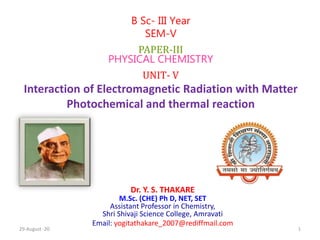
Lect. 2 interaction of emr photochemical and thermal reaction
- 1. Dr. Y. S. THAKARE M.Sc. (CHE) Ph D, NET, SET Assistant Professor in Chemistry, Shri Shivaji Science College, Amravati Email: yogitathakare_2007@rediffmail.com B Sc- III Year SEM-V PAPER-III PHYSICAL CHEMISTRY UNIT- V Interaction of Electromagnetic Radiation with Matter Photochemical and thermal reaction 29-August -20 1
- 2. Interaction of Radiation with Matter When light falls on matter, part of it reflected, part of it is transmitted and some part of it is absorbed. In photochemistry we are concerned with the part of light which is absorbed. The light radiations of the visible and ultraviolet regions lying between 800 nm and 200 nm wave length are chiefly involved in bringing about photochemical reactions. The relative photons should be of sufficient energy to raise the atom or molecule from the ground electronic state to an excited electronic state. When light radiation of suitable energy absorbed by the matter, electronic transitions, vibrational changes or rotational changes or combination of these take place. The atoms and molecules become excited. They give out energy quickly either by losing energy in the form of heat or by reemitting the light or they may get dissociated yielding atoms, molecules or free radicals in the primary processes. In secondary process the excited atoms, molecules or free radicals produced in primary stage react further giving rise to different products.29-August -20 Dr. Yogita Sahebrao Thakare
- 3. 29-August -20 Dr. Yogita Sahebrao Thakare
- 4. 29-August -20 Dr. Yogita Sahebrao Thakare 1. Primary Photochemical Process: A chemical reaction wherein photon is one of the reactant
- 5. 29-August -20 2. Secondary process: This involves reaction of activated molecules of primary process with other molecules resulting into activation or deactivation Dr. Yogita Sahebrao Thakare
- 6. Types of Chemical Reactions A chemical reaction is define as one in which the identity of molecule is lost due to the rupture and formation of chemical bonds. Chemical reactions are two types. (a) Dark or Thermal Reactions The reaction taking place in absence of light are called dark or thermal reactions. These are the ordinary chemical reactions which are influenced or induced by temperature, concentration of reactants, presence of a catalyst etc. except light radiations. Examples of dark reactions are: (i) N2+3H2 2NH3 (ii) H2+I2 2HI (ii) PCl5 PCl3 + Cl2 The Various characteristics of dark or thermal reactions are: (i) These reactions need collisions for activation. (ii) Their rate depends on temperature. (iii) These reactions take place with decrease of free energy.29-August -20 Dr. Yogita Sahebrao Thakare
- 7. (b) Photochemical Reaction Photochemical reaction may be defined as any reaction which is induced or influenced by the action of light on the system. Examples of Photochemical reactions are (i) Dissociation. (ii) Photo-catalytic reactions. (iii) Rearrangement (iv) Combination. (v) Decomposition (vi) Polymerization. (vii) Addition reaction. 29-August -20 Dr. Yogita Sahebrao Thakare
- 8. Comparison between thermal and photochemical reactions: Thermal reactions 1. These reactions are initiated by collisions between molecules of reactant. 2. In thermal reactions, free energy of molecules decreases. 3. Thermal reactions are simple in nature. 4. Thermal reactions are generally fast. 5. The rate of thermal reactions depends on the temperature. Photochemical reactions 1. These reactions are initiated by absorption of light radiations of visible and ultra violet region. 2. In photochemical reaction free energy of molecules increases. 3. Photochemical reactions are complex in nature. 4. Photochemical reactions are slow. 5. The rate of photochemical reaction independent of temperature. 29-August -20 Dr. Yogita Sahebrao Thakare
